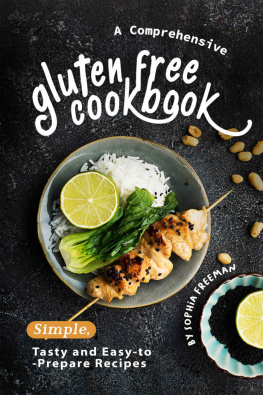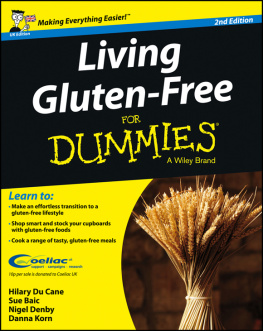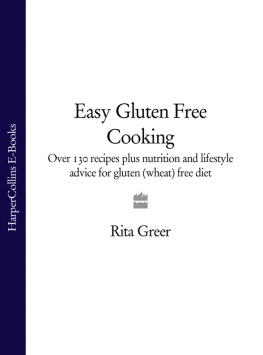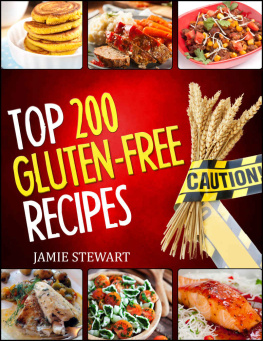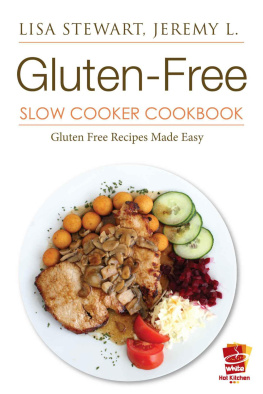GOING GLUTEN-FREE
7 Surprising Facts YouShould Know
If You Want to AchieveDietary Success
By
Heather K. Jacobsen
Copyright 2016 HeatherJacobsen
ISBN:978-13107810-2-5
SmashwordsEdition
Written and Illustrated byHeather Jacobsen
Cover Design by HeatherJacobsen
All RightsReserved
Thank you for downloadingthis ebook. This book remains the copyrighted property of theauthor, and may not be redistributed to others for commercial ornon-commercial purposes. If you enjoyed this book, please encourageyour friends to download their own copy from their favoriteauthorized retailer. Thank you for your support.
Disclaimer: This book isintended for informational purposes only and is not meant tosubstitute for the advice, diagnosis or treatment of a health careprofessional. The a uthor accepts noliability for any injury caused or alleged to be caused as a resultof the use, application or interpretation of the material in thisbook.
www.hkjacobsen.com
Table ofContents
Introduction
Are you new to gluten-free? Or have you beengluten-free for a while but still continue to have chronic symptomsof one kind or another? Either way, the seven facts in this bookwill help you achieve dietary success.
But first, a little about me: everyonesgluten story is different. My story has changed. A lot. At first Iwas just gluten-free. I have been gluten-free since 2001, longbefore gluten-free began trending in cyberspace and themarketplace. I diagnosed myself after a childhood of chronicillness and a young adulthood writhing in abdominal discomfort.
In 2011, I launched thecommunity website, StuffedPepper . It was meant to be a collective, where people in thegluten-free space could share knowledge and ideas of thegluten-free lifestyle. I envisioned my role as facilitator ofdiscussions and curator of resources.
But something strange happened to me as Ibegan Stuffed Pepper. After several years of a not very carefulgluten-free diet, because no doctor gave me a definitive diagnosisof celiac disease or gluten sensitivity, and thus no oneindoctrinated me on the right way to go gluten-free, I became sickall over again. I developed terrible brain fogs, debilitatinginsomnia and began reacting to other foods beyond gluten, puttingmy digestive system in a constant state of distress. I removeddairy and soy from my diet, but it turned out I was reacting to aninexplicably large variety of foods, meaning I had developedintestinal permeability (also known as leaky gut), as well ascandida (excess yeast in the gut), and I had the inability todigest most sugars. My conventional doctor didnt believe any ofit. Not gluten sensitivity. Not yeast overgrowth. Not leakygut.
Fifteen years later, I feel that I amfinally getting back to a state of normalcy. Much of this is due toconducting my own medical and nutritional research, listening to myown body, and hearing anecdotal stories of others who have reversedautoimmune diseases or found health again through diet. Now, I havefinally found the right diet and the right path to optimizedhealth. I dont want you to have to go through a decade and ahalf of research or trial and error before you start to feel wellagain. Thats why I started Stuffed Pepper. And thats why I wrotethis book, meant for both celiacs and those with glutensensitivity.
Following are seven things you need to knowabout going gluten-free that you might not have considered yet.This will help you get on the right path to dietary success. Andwhen you have finished reading and understanding these facts,please download a free gluten-free meal plan at Stuffed Pepper, andcash in your 50% off coupon code for our 30-day plan, if youdlike.
FACT #1
You dont have to be diagnosed with celiac disease to have aproblem with gluten
Some of us are just more susceptible to glutenswrath.
In fact, many refer to c eliac disease as just the tip of theiceberg of gluten-related disorders. Still others believethat gluten sensitivity could be a precursor to celiacdisease.
However , thedifference between the two is that, in celiac disease, glutentriggers the body to attack its own intestinallining.
to name a couple.
and skin diseases are some examples of this. This often makesGS difficult to diagnose. Another reason its difficult to diagnoseis because its symptoms can be manifested completely differentlyfrom one person to the next. Also, testing for GS is not black andwhite. While some people produce antibodies to gluten (IgG- andIgA-AGA), there are researchers who say this method of testingisnt specific enough since many people produce these antibodies togluten. Thus, the normal range of gluten antibodies in the blood isarbitrary. Other researchers say that producing antibodies togluten is an obvious reaction to it, so this is an indication ofsome form of gluten sensitivity, even if there isnt a specificailment linked to it. I agree with this thinking.
So if youre not feelingwell and you think gluten is the culprit, dont worry about whetheror not your doctor can produce a positive diagnosis of celiacdisease or even of gluten sensitivity. You can (and should) wait tostart your gluten-free diet until after any biopsies and bloodtests are taken, in order to get the most precise diagnosis thatyou can. See here for more information on how to test for celiacdisease.
But if youve had all yourtests, and the resulting diagnosis was negative for celiac disease,do not rule out gluten sensitivity. If you have chronic illness ofone kind or another, gluten may still be the culprit. You can startby taking this self-diagnostictest to see if any of thesymptoms ring true for you. If they do, you have nothing to lose byeliminating it from your diet. Then you can reintroduce gluten at alater date (if you are up for it!) to see if your body once againreacts.
In addition, it is known,although not well studied at this time, that the lectin in wheat canadversely affect anyone, not just the gluten sensitive. Well talkmore about lectins later.
conditions not necessarilyassociated with celiac disease or a gluten sensitivity.
Whether you have celiac disease or glutensensitivity, you need to take glutens effects on your body veryseriously. You should also be aware of the next six facts.

Specifically, antibodies totissue transglutaminase (tTG) or endomysium (EMA), indicators thatthe body is attacking itself, are negative for gluten sensitivity but positive for celiac disease.However, antibodies to gliadin, a fraction of the gluten protein,can be positive in gluten sensitivity as well as in celiacdisease .
FACT#2
Most people aren't healing on theconventional gluten-free diet
So its not surprising to see so many people goinggluten-free these days.
Ifind this statistic staggering and wonder why more people in the GFcommunity arent talking about it. Instead, prominent authoritieson celiac disease will tell you the oppositethat patients areresponding positively to the diet the majority (85-90%) of thetime. How can this be?
. Although not quite as direas the 8% recovery rate that I first mentioned, no matter how youlook at it, the vast majority of celiacs are not healing on thegluten-free diet as we know it.
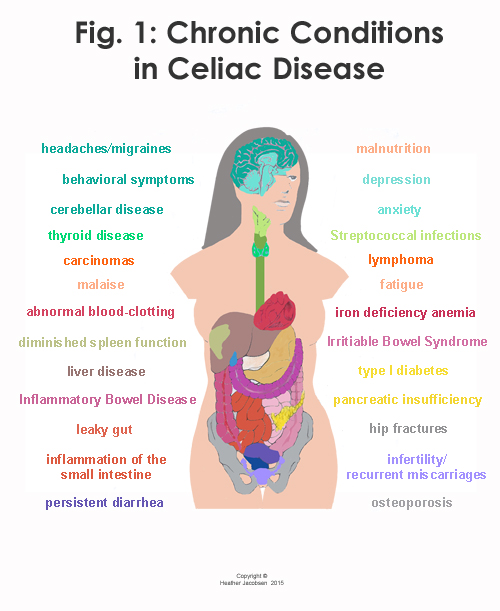
So itis of utmost importance that celiacs heal their guts. This is alsoimportant for non-celiacs with gluten sensitivity, whom Ivealready mentioned have a higher mortality rate than celiacs,because, again, if celiacs arent healing their guts on thegluten-free diet, how do we know if its effective fornon-celiacs?


